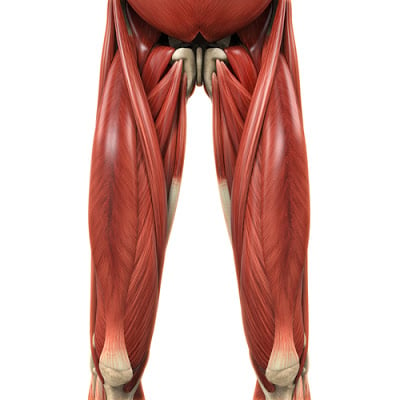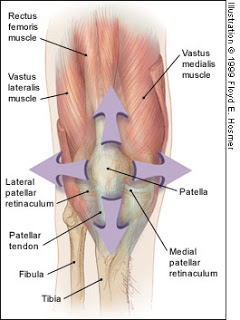
Over the last few weeks, we have been discussing the importance of soft tissue release for managing pain, injury, posture, and performance. Today we will move up the kinetic chain from the feet and lower leg into the thigh where we find the bulk of the lower body musculature. One of the major roles of this musculature is to control the knee joint; the largest and most complicated joint.
Overall, knee injuries make up about 55% of all sports injuries. Yet these incidences are not being reduced, and in some cases like this NFL preseason, are actually increasing as we become more knowledgeable about this joint’s effect on the body.

The knee joint is responsible for maintaining the entire weight of body (force), over the greatest distances (the femur is the longest bone in the body). So one of the key structures for this joint’s performance is the patella, or knee cap, because this floating bone increases the leverage (force) that the tendon can exert on the femur by increasing the angle at which it acts. It basically inserts a pulley into the line of force or pull.
This floating bone, a sesmoid, has several attachments from the quadriceps muscles above. As a result, the knee cap is prone to being pulled in different directions, which can cause wear and tear on the hinge joint if the alignment is not straight. This misalignment is called patellar tracking, defined as the motion of the patella relative to the femur or femoral groove during knee flexion and extension. So abnormalities of tracking are thought to relate to many disorders of the knee joint.
So the knee joint is the remote outpost that connects the supply chain of force from the most powerful joint (hips) to the front lines of the feet, which transmit/absorb force first from the ground. As a remote outpost, the knee is under attack from all angles. The result of this constant barrage of forces is a long list of potential injuries like tendinosis, ligament and meniscus sprains and tears, chondromalecea, and lots of unidentified pain and discomfort that many of us feel on a regular basis. Avoiding knee use is not an option, so the only solution is to cultivate the structures protecting the knee.
Outside of traumatic injuries from a car crash or contact sport, knee injuries come down to poor tracking. Poor tracking results in both overuse and inefficiency of the supporting structures that create forces, such as muscles and tendons. Eventually these structures become inflamed and painful, which is the fundamental explanation of musculo-skeletal pain.
The quads are the fortification structures of the knee. They do a great job maintaining the function of a joint that is required to do a tremendous amount of work. But, like anything, the muscles of the quad can only take so much abuse before they breakdown. This breakdown results in compromised knee function, tendinopathy, and pain. Soft tissue release is the key to caring for these tissues so that they will be there for you in the long haul.
Roll the Lateral Quad – 45 degree angle just above the knee (3-4 inches). Use a side to side rocking motion, flex the knee, and pull the heel toward the butt in order to break apart the stiffness and tension in the lateral quad.
Roll the IT Band – use small rolling motions from the hip all the way down to the knee. Focus your attention on the front edge (along the quads) or the back edge (along the hamstrings) in order to get the IT Band “unstuck” from the underlying tissues.
Roll the Middle Quad – get one leg on the end of the roller and work from the hip flexor down to the knee. Rock side to side searching for “lumps” in the quad. Flex the knee to release these trigger points
Check back next week as we wrap up our series on soft tissue management with a look at the muscles of the hip, not the biggest, but the most powerful joint in the body.